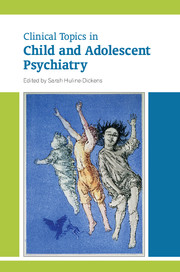Book contents
- Frontmatter
- Contents
- List of tables
- List of boxes
- List of figures
- List of contributors
- Preface
- 1 Child psychiatry and the people who have shaped it
- 2 Fabrication and induction of illness in children
- 3 Personality disorders as disorganisation of attachment and affect regulation
- 4 Post-traumatic stress disorder and attachment: possible links with borderline personality disorder
- 5 Management of antisocial behaviour in childhood
- 6 Pharmacology for attention-deficit hyperactivity disorder, Tourette syndrome and autism spectrum disorder
- 7 Pharmacology for anxiety and obsessive–compulsive disorders, affective disorders and schizophrenia
- 8 Pharmacological management of core and comorbid symptoms in autism spectrum disorder
- 9 Pharmacological treatment of depression and bipolar disorder
- 10 Cognitive–behavioural therapy with children, young people and families: from individual to systemic therapy
- 11 Anxiety disorders
- 12 Somatising: clinical presentations and aetiological factors
- 13 Somatising: management and outcomes
- 14 Evaluating psychological treatments for children with autism
- 15 Attention-deficit hyperactivity disorder: assessment and treatment
- 16 Schizophrenia
- 17 Tourette syndrome
- 18 Sleep disorders
- 19 Self-harm in adolescents
- 20 Adolescent substance misuse: an update on behaviours and treatments
- 21 Eating disorders
- 22 Gender dysphoria in young people
- 23 The psychiatry of children aged 0–4
- Index
22 - Gender dysphoria in young people
Published online by Cambridge University Press: 02 January 2018
- Frontmatter
- Contents
- List of tables
- List of boxes
- List of figures
- List of contributors
- Preface
- 1 Child psychiatry and the people who have shaped it
- 2 Fabrication and induction of illness in children
- 3 Personality disorders as disorganisation of attachment and affect regulation
- 4 Post-traumatic stress disorder and attachment: possible links with borderline personality disorder
- 5 Management of antisocial behaviour in childhood
- 6 Pharmacology for attention-deficit hyperactivity disorder, Tourette syndrome and autism spectrum disorder
- 7 Pharmacology for anxiety and obsessive–compulsive disorders, affective disorders and schizophrenia
- 8 Pharmacological management of core and comorbid symptoms in autism spectrum disorder
- 9 Pharmacological treatment of depression and bipolar disorder
- 10 Cognitive–behavioural therapy with children, young people and families: from individual to systemic therapy
- 11 Anxiety disorders
- 12 Somatising: clinical presentations and aetiological factors
- 13 Somatising: management and outcomes
- 14 Evaluating psychological treatments for children with autism
- 15 Attention-deficit hyperactivity disorder: assessment and treatment
- 16 Schizophrenia
- 17 Tourette syndrome
- 18 Sleep disorders
- 19 Self-harm in adolescents
- 20 Adolescent substance misuse: an update on behaviours and treatments
- 21 Eating disorders
- 22 Gender dysphoria in young people
- 23 The psychiatry of children aged 0–4
- Index
Summary
The film Boys Don't Cry illustrates in a highly dramatised form the problems that the phenomenon of gender dysphoria (gender identity disorder in DSM-IV; American Psychiatric Association, 1994) can create in an extreme situation. The film is based on the true story of a young person, Brandon, with a female body who perceived himself as a male. We are not told when the issue of his male gender identity first appeared, but we see him living in a male role as a teenager trying to conceal from his peers the reality of his female body. The struggles of these concealments are well portrayed, as in the scene when Brandon steals tampons from a shop. He joins in male activities and displays of physical strength as a confirmation of his male role. He is well accepted as a boy within a troubled and troublesome group of young people. He falls passionately in love with a girl, Lana, who accepts him as he is without much questioning, and a close intimate relationship develops, which the peer group seems to accept. The reality of his body is eventually revealed. Lana can accept the new situation, but had she really not known or had she turned a blind eye? Unfortunately, two young men become more and more disturbed by this realisation. It stirs a primitive violence in them, which leads first to Brandon's rape and then to his murder.
How can we make sense of this complex tragedy? I would like to suggest that unbearable identity confusion in the two young attackers, against a social background of strong prejudice and stigma, is what leads to the violence. It is aimed at changing Brandon but eventually destroys him when he does not submit to their views of order on gender and sexual matters. For them, having a female body is inextricably connected with having a female identity. Any digression from this rule is a terrible threat to their fragile sense of identity. Obviously, other factors can be invoked in making sense of their behaviour, but these are beyond the scope of this chapter.
The establishment and maintenance of secrecy regarding gender can have serious psychosocial consequences, as the film shows when Brandon's secret is suddenly revealed.
- Type
- Chapter
- Information
- Clinical Topics in Child and Adolescent Psychiatry , pp. 349 - 364Publisher: Royal College of PsychiatristsPrint publication year: 2014

